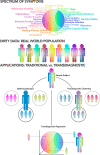Predicting the future of neuroimaging predictive models in mental health
- PMID: 35697759
- PMCID: PMC9708554
- DOI: 10.1038/s41380-022-01635-2
Predicting the future of neuroimaging predictive models in mental health
Abstract
Predictive modeling using neuroimaging data has the potential to improve our understanding of the neurobiology underlying psychiatric disorders and putatively information interventions. Accordingly, there is a plethora of literature reviewing published studies, the mathematics underlying machine learning, and the best practices for using these approaches. As our knowledge of mental health and machine learning continue to evolve, we instead aim to look forward and "predict" topics that we believe will be important in current and future studies. Some of the most discussed topics in machine learning, such as bias and fairness, the handling of dirty data, and interpretable models, may be less familiar to the broader community using neuroimaging-based predictive modeling in psychiatry. In a similar vein, transdiagnostic research and targeting brain-based features for psychiatric intervention are modern topics in psychiatry that predictive models are well-suited to tackle. In this work, we target an audience who is a researcher familiar with the fundamental procedures of machine learning and who wishes to increase their knowledge of ongoing topics in the field. We aim to accelerate the utility and applications of neuroimaging-based predictive models for psychiatric research by highlighting and considering these topics. Furthermore, though not a focus, these ideas generalize to neuroimaging-based predictive modeling in other clinical neurosciences and predictive modeling with different data types (e.g., digital health data).
© 2022. The Author(s).
Conflict of interest statement
The authors declare no competing interests.
Figures



References
Publication types
MeSH terms
Grants and funding
LinkOut - more resources
Full Text Sources
Medical
Research Materials

